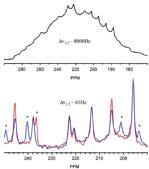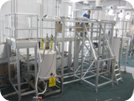Methodology Development
Spinning-angle encoding
 Using a fast angle-switching probe technology developed by Ago Samoson, we have shown how dipolar couplings corresponding to distances over 4 Å can be quantitatively determined using off-magic-angle spinning during spin-echo evolution employing a doubly-selective cosine modulated pulse to select the specific pair of spins of interest (Becker-Baldus 2011).
Using a fast angle-switching probe technology developed by Ago Samoson, we have shown how dipolar couplings corresponding to distances over 4 Å can be quantitatively determined using off-magic-angle spinning during spin-echo evolution employing a doubly-selective cosine modulated pulse to select the specific pair of spins of interest (Becker-Baldus 2011).
DOR
 |
Magic Angle Spinning (MAS) although very successful in many applications often struggles to provide the required resolution for NMR of quadrupolar nuclei (top of diagram to the left); this is due to the residual second-order quadrupolar broadening. DOuble Rotation (DOR) is a method where the sample is spun around two angles at the same time and thus removing the anisotropic quadrupolar interaction completely. Due to the technical difficulties in achieving this Dr Ago Samoson's group has been the only group which has been able to produce DOR probes. Again due to the technical difficulties in running DOR experiments groups which are capable of running DOR experiments are particularly rare and Warwick has been at the forefront of this technique since the late 90's. We have been instrumental in applying DOR in many areas including DOR NMR of 17O in biomolecules resulting in lines which are 120 times narrower than under MAS alone as shown in this JACS paper (and the picture to the left) and Multiple Quantum DOR allowing the separation of the isotropic chemical shift and second-order quadrupolar shift. More recently, we are investifating spin-diffusion experiments conducted under DOR (Hung 2009) |
DNP
|
The main problem behind NMR is that it is a relatively insensitive technique with spin polarisations of 0.015 % (1H at 20 T at 300 K) to 4.2x10-7 % (197Au at 20 T at 300 K). A huge advantage behind EPR is that the spin polarisations are much larger 1.5 % (3.3 T at 300 K). Dynamic Nuclear Polarisation (DNP) is a technique whereby spin polarisation is transferred from the electrons to the nucleus giving a maximum potential increase in signal strength of between 600 and 37000 times depending on the nucleus. The DNP journey in Warwick started in February 2007 when we began a £3.7M project as part of a UK Research Council's Basic Technology Research Programme: D2NP — New frontiers in electron enhanced high field solid state NMR for interdisciplinary science and technology. In April 2008 we started moving in equipment and development of the technique started. We have two systems, one of which is a 3.3 T NMR magnet with a 94 GHz Pulsed Bruker EPR system equiped with an Extended Interaction Klystron and a Varian Infinity NMR console (Kryukov 2010). The other system is 14.6 T high resolution sweepable NMR magnet with a Varian NMR console and a 187/395 GHz gyrotron (Pike 2012). With the appointment of Dr Gavin Morley our DNP research has taken a slightly different direction with the aim to develop DNP using low power sources and N@C60 |
|
Low γ and "Unusual" Nuclei
|
Green — High γ |
The majority of the NMR active nuclei are rarely studied by the NMR community due to various experimental difficulties and the lack of previous information i.e. shift ranges. At Warwick we try to expand the range of widely studied nuclei in solid-state NMR, obtaining experimental and analysis protocols of previously unstudied or rarely studied nuclei. Warwick has a strong tradition in this area, with some of the first papers published on high-resolution 17O, natural abundance 43Ca and 25Mg NMR. Among such "unusual" nuclei, we study 10B, 14N, 17O, 33S, 35Cl, 43Ca, 47Ti, 49Ti, 59Co, 65Cu, 77Se, 87Sr, 89Y, 93Nb, 119Sn, 125Te, 133Cs, 137Ba, 139La and 205Tl. We have a long history with both 17O and 43Ca, more recently extending the use of 17O to biomolecules and conducting 1H-43Ca correlation experiments on hydroxyapatite.
|


